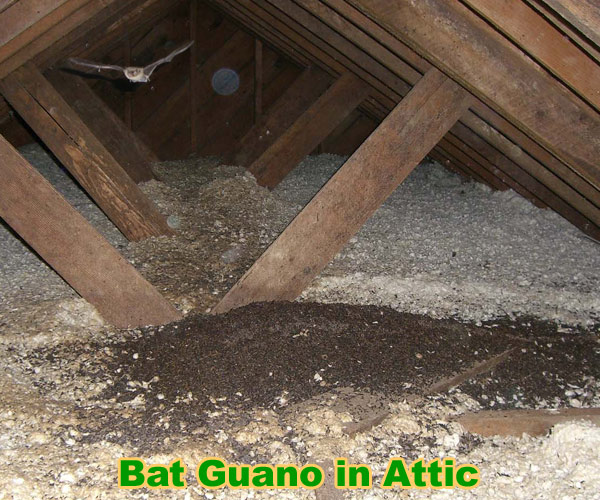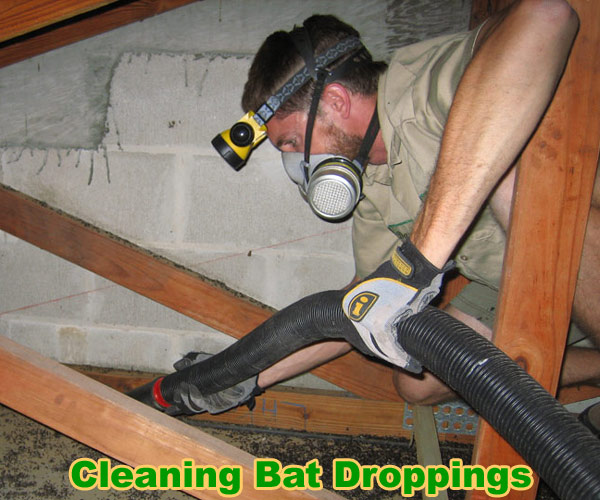- info@wildlife-removal.com
Call us for help in your town
Wildlife Removal Education
How To Clean Bat Guano
Need bat removal in your hometown? We service over 500 USA locations! Click here to hire us in your town and check prices - updated for year 2020.
One of the biggest problems that comes with having a colony of bats roosting in a building is the large amount of waste, or guano, left behind. Bats eat a lot of
insects, and have a high metabolism, and each bat poops 20-30 times per day, leaving behind a whole heck of a lot of bat poo! These are the primary reasons you want
to clean up the guano after the bats are gone:
- The guano can grow a type of fungus that can cause the lung disease histoplasmosis in humans.
- The same can happen to pets too. What Diseases Can Bats Give to Pets?
- The droppings just plain smell bad, and in quantity, have an odor that can overpower the house.
- The droppings and urine are corrosive to wood and metal, and can compromise the structural integrity of the building. In short, the wood can rot.
- The droppings and the scent will lure in other animals and insects - I often see hundreds of cockroaches crawling on bat guano.
- Read about How Dangerous Are Bat Droppings?

This is a modest pile of bat guano in an attic. However, droppings were scattered throughout the entire attic space, of course. For a full cleanout and deodorization, all of the
soiled insulation had to be removed. Here are the proper steps for cleaning bat guano out of an attic or any other space:
Step 1: Make certain the bats are all removed, and the building is sealed so none can get back in.
Step 2: Remove lose droppings on smooth surfaces by vacuum, as seen in the below photo, and scrub such surfaces with an enzyme-based cleaner.
Step 3: Remove all soiled insulation - you're not going to be able to clean it. If it's not too badly soiled, you can just spray it with the cleaner.
Step 4: Fog the entire attic space with the special cleaner. I use an electric atomizer, and an enzyme-based cleaner. There are several brands, but I've been using Bac-Azap. Bioshield is good too.
These products help break down the organic material. The fogger makes sure that every nook and cranny is covered. What do I need to do after removing bats from my house?
You can read more about the process here: attic restoration. This page shows the biohazard suit and equipment that I use. Some people are worried about lung diseases. Read Histoplasmosis From Bats: What You Need to Know.
Does homeowner's insurance cover the removal of bats or bat droppings and attic restorations and cleanouts? Read
The truth about bats and homeowners insurance

Here's a photo of me vacuuming out the remnants of bat droppings on the sheetrock (ceiling drywall) of an attic after the insulation has been removed. How To Remove Bat Feces From Concrete
As stated, each bat leaves 20-30 droppings per day (depending on time of year and how much it eats, of course). If you've got a colony of a thousand
bats in your attic, multiply 20-30,000 bat droppings times the number of days the bats are in there, and though the droppings are small, you can wind up with a huge buildup. In the worst case
I've ever seen, a colony of about 3000 Little Brown Bats went unchecked in a Pennsylvania attic for many years. The ceilings were buckling under the weight of two feet deep of
consistent bat guano throughout the whole attic. It was amazing, and required an amazing cleanout job. I wish I had taken photos then. And don't forget about Bat Urine Removal And Urine Stain Removal.
I have written several other detailed articles:
How to get bats out of the attic
Remove bats flying inside the house
How to get bats out of the chimney
Bat exclusion tips and techniques
Bat trapping
How to catch a bat
How to inspect your house for bat entry
Bat prevention methods
What does a Mexican freetail bat look like?
4 Steps to Removing Bat Guano the Right Way
The author, David, is a bat removal expert with
over 500 successful bat control jobs under his
belt. I want to stress the importance of proper
bat removal, and the value of these animals to
the ecosystem. I've witnessed dozens of failed
do-it-yourself bat jobs over the years, and it
is not pretty - dead bats, horrible odors,
rabies vaccinations, and so on. Bat removal work
is not easy - I trained for two years learning,
and even then, it took many jobs and hands-on
training before I was competent. I highly
recommend that you consult my list of wildlife
control companies on the home page, and hire a
professional to come out and look at your bat
problem. Get a few quotes if you must. And
remember, do not perform any bat exclusions during the summer maternity months. For more general information and links, go to my main bat removal page.
Customer Bat Email: Hey David. My name is Scott. My business partner and I also do wildlife control. We are full time fireman and have worked in the industry for sometime now for one of the "other" companies in the area.
We branched out on our own do to the lack of customer service provided from our previous employer. We believe that we are better serving both the customer and the wildlife being trapped and removed then most of our competitors.
We have recently started undertaking more of the cleanup and repairs associated with the business. We are curious what cleaning solution and atomizer you are using for the post bat cleanup in attics. We too remove the feces and
old insulation by hand and we are preparing to purchase our own HEPA vac. I appreciate your website it helps the customer understand so much about what we do. I don't know how many customers I have had review your site for information.
Thanks for all you have done and I look forward to hearing from you.
My Response: Scott, Thanks for writing. The product I use is Bac-Azap (though several work), and I use the atomizer sold on WCS. It does a good job of fogging the entire attic space, even down the walls, to get every
last nook and cranny. The enzymes in the cleaner break down the bat guano and urine, and kill fungus, and deodorize the attic space. Read more about Problems Caused by Nuisance Wildlife.
Pets finding dead bats: what you should really be worried about


















